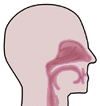  |
||
 |
January 2018Smell loss (hyposmia) is a lifelong, chronic sensory diseaseSmell loss (hyposmia) occurs in about 7% of the U.S. population. It is comprised of a heterogeneous group of diseases with three major groupings: direct (brain or nerve injury), congenital (genetic factors) or acquired (biochemical causes). Smell loss most commonly occurs with acquired factors with specific biochemical pathology initiating the disorder associated with a variety of clinical conditions, e.g., post-viral infection, chronic allergic rhinitis, head injury, inhalational anesthesia and other conditions. The biochemical mechanisms underlying both acquired and congenital hyposmia relate to inhibition of olfactory epithelial receptor cell function due to altered secretion of specific growth or transcription factors in nasal mucus which are required to initiate olfactory receptor stem cell generation and perpetuation. Some growth/transcription factor secretions are decreased to cause these dysfunctions. They include hormones, vitamins, trace metals and a group of biochemical growth/transcription factors – cAMP, cGMP and sonic hedgehog. Some growth/transcription factor secretions are increased to cause these dysfunctions – these are “death factors” which act to inhibit olfactory receptor function. These include cytokines such as TNFalpha. Treatment with oral or intranasal phosphodiesterase (PDE) inhibitors increase secretion of decreased growth/transcription factors and decrease secretion of “death factors” such that stem cells in the olfactory epithelium are stimulated to initiate receptor growth and development. Treatment with PDE inhibitors are required to provide continual stimulation of these stem cells since they initiate the cellular activity by which these receptors (which do not contain blood vessels, lymphatics or exhibit mitosis but turn over rapidly, commonly on a daily basis) are stimulated. In this sense, hyposmia is a chronic disease process similar to diabetes or arthritis. While the disease can be treated it is a lifelong, chronic disorder. ReferenceHenkin RI, Levy LM, Fordyce A. Taste and smell function in chronic disease: A review of clinical and biochemical evaluation of taste and smell dysfunction in over 5000 patients at The Taste and Smell Clinic in Washington, DC. Am J Otolaryngol. 2013;34:477-489. |
|